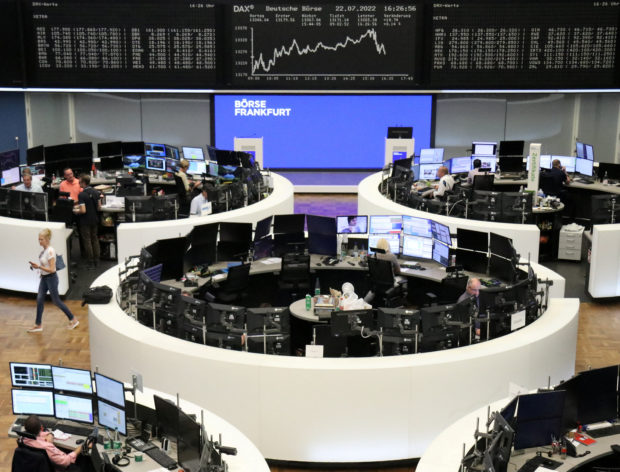
The German share price index DAX graph is pictured at the stock exchange in Frankfurt, Germany, July 22, 2022. REUTERS/Staff
LONDON/SINGAPORE – Global stocks rose on Friday, on course for their best month since late 2020 as traders bet a weakening U.S. economy could slow the pace of monetary tightening in the world’s largest economy, while the dollar struggled broadly against its rivals.
As inflation surges across major markets and central bankers fight to raise rates without killing off growth, riskier markets like stocks have tended to react positively to any softening in sentiment on the part of policymakers.
After Thursday data showing a second-quarter contraction for the U.S. economy helped U.S. markets rise strongly, European shares shrugged off weakness in Asian markets overnight to gain at the open.
Futures markets now predict that U.S. interest rates will peak by December this year compared to June 2023 at the start of July month and the Federal Reserve will cut interest rates by nearly 50 bps next year to support slowing growth.
The MSCI World index was last up 0.3 percent, on course for a near-6 percent monthly gain, its best since November 2020, buoyed by broad gains across European markets, with the STOXX Europe 600 up 0.8 percent.
U.S. stocks look set to gain later in the session, with futures for the S&P 500 and Nasdaq up 0.7 percent and 1.4 percent, respectively, buoyed in part by strong overnight earnings from Amazon and Apple.
Despite the positive end to the month for stocks, Mark Haefele, Chief Investment Officer at UBS Global Wealth Management, said investors should proceed with caution.
“In the near term, we think the risk-reward for broad equity indexes will be muted. Equities are pricing in a ‘soft landing’, yet the risk of a deeper ‘slump’ in economic activity is elevated.”
Some of that concern had been evident in Asian stock markets overnight, after Beijing omitted reference to its full-year GDP growth target after a high-level Communist Party meeting.
MSCI’s broadest index of Asia-Pacific shares outside Japan fell 0.3 percent.
News in the prior session that U.S. gross domestic product had shrunk 0.9 percent last quarter, to add to a 1.6 percent contraction in the quarter before that, weighed on the country’s bond yields and the greenback and both remained subdued on Friday.
The weakness came despite the Federal Reserve on Wednesday k delivering an aggressive interest rate hike of 75 basis points, its third this year.
The yield on benchmark 10-year Treasury notes recovered slightly from its overnight lows to trade at 2.6975 percent while the two-year note’s yield, which typically moves in step with interest-rate expectations, was at 2.8500 percent.
The dollar was last down 0.5 percent against a basket of its major peers – yet still on course for a second month of gains – leaving the yen eyeing its best month in two years as the fall in U.S. Treasury yields weighed on the greenback.
In Europe, Germany’s 10-year bond yield – the benchmark for the euro zone – was up almost 5 basis points in early trade at 0.85 percent yet that still leaves it down 50 bps on the month, on course for its weakest showing since 2010.
Across commodities, Brent crude futures and U.S. West Texas Intermediate crude were last up 1.3 percent-1.7 percent as concerns about supply shortages ahead of the next meeting of OPEC ministers just about offset doubts around the economic outlook.
Gold extended its overnight gains to trade up 0.6 percent to $1,765 an ounce, helped by the weaker dollar.

